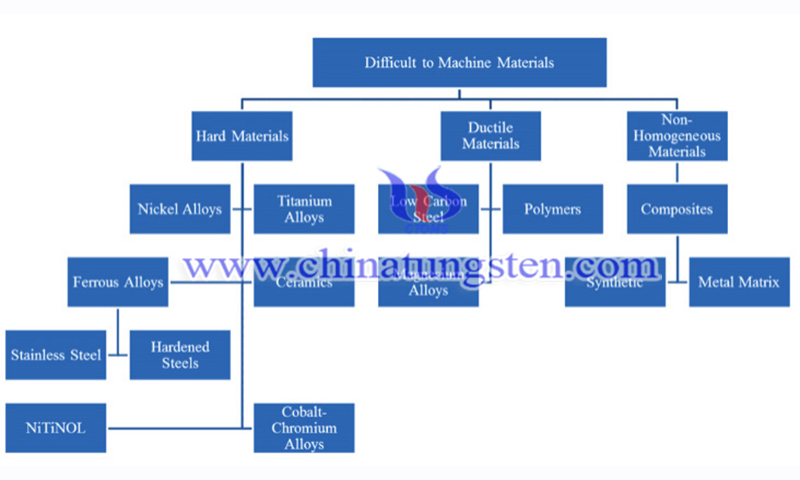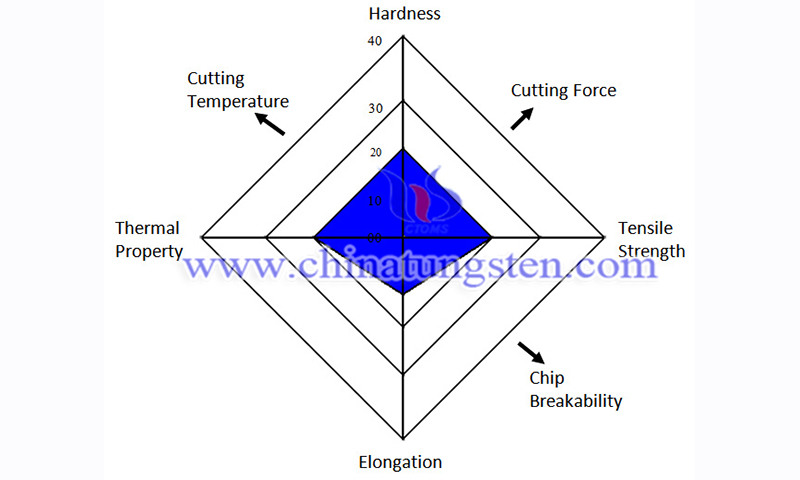Machinability of Cobalt Chromium Molybdenum Alloys—Ⅱ
- Details
- Category: Tungsten Information
- Published on Tuesday, 11 October 2022 20:43
In general, the term machinability can be defined as how easily the material can be machined or cut to the desired shape in terms of tool and process conditions, taking into account surface finish and tool life. The machinability of cobalt chromium molybdenum alloys is comparable to other advanced materials such as nickel and titanium alloys, which are classified as difficult-to-cut materials due to their unique characteristics of high strength, toughness, wear resistance, and low thermal conductivity.
The polarity diagram for the hard-to-cut grade (DTCR) or machinability grade of CoCrMo alloys shows the material properties of the hard-to-cut material compared to free-machining steel or medium carbon steel (0.45% C). The effect of the high hardness of the CoCrMo alloy increases the resistance to deformation, which also leads to an increase in cutting forces and cutting resistance.

Typically, machining high-hardness materials such as cobalt chromium molybdenum alloys create many undesirable problems, often related to the short life of the cutting tool and poor surface quality due to heat generation and plastic deformation. The low thermal conductivity of cobalt-chromium-molybdenum alloys tends to increase the wear of cutting tools due to a large amount of heat transferred to the cutting edge during the cutting process.
Minimizing the cutting speed, feed rate, and depth of cut during machining, while using sharp cutting-edge tools, can reduce the high cutting temperature in the cutting zone. The reduction of cutting feeds has an additional effect on reducing the mechanical load on the cutting tool.
In addition to the above parameters, several other factors can affect the machinability grade of CoCrMo alloys, such as tool geometry, tool material, cutting conditions, material conditions, and the type of cooling and coolant used. When machining difficult-to-cut, high-temperature materials, the researcher offers several recommendations, including the use of positive front-angle tools to minimize work-hardening and the build-up of edges on the machined surface by shearing chips away from the workpiece.

In addition, sharp cutting edges can improve surface quality by preventing material buildup during machining. At the same time, the tool and machine should be purely safe to avoid chattering and vibration, which can have a significant impact on surface quality and tool breakage.
Cited paper: Zaman H A, Sharif S, Kim D W, et al. Machinability of cobalt-based and cobalt chromium molybdenum alloys-a review[J]. Procedia Manufacturing, 2017, 11: 563-570.
| Molybdenum Supplier: Chinatungsten Online www.molybdenum.com.cn | Tel.: 86 592 5129696; Fax: 86 592 5129797;Email:sales@chinatungsten.com |
| Tungsten News & Prices, 3G Version: http://3g.chinatungsten.com | Molybdenum News & Molybdenum Price: http://news.molybdenum.com.cn |



 sales@chinatungsten.com
sales@chinatungsten.com